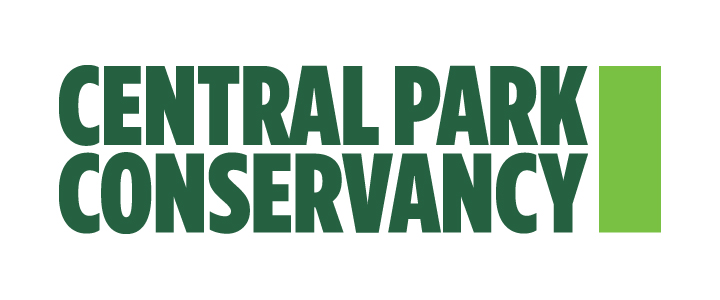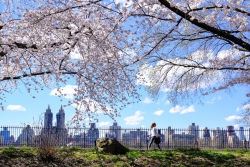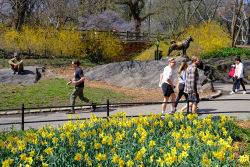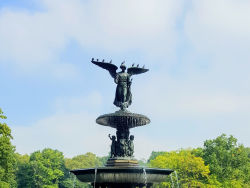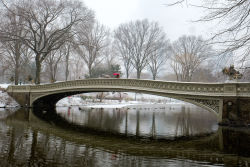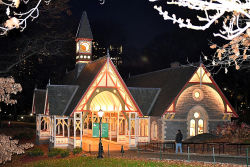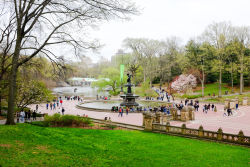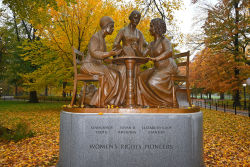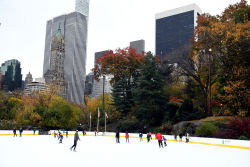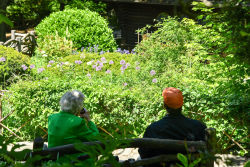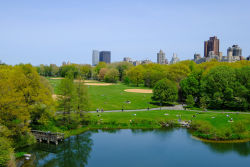Central Park
View all monuments in NYC Parks, as well as temporary public art installations on our NYC Public Art Map and Guide.
Bethesda Terrace
| Location: | North of Mall, off 72nd Street |
Artwork History
In their 1858 Greensward Plan for Central Park, Frederick Law Olmsted (1822-1903) and Calvert Vaux (1824-1895) proposed an architectural "open air hall of reception" for this area. They imagined a sweeping promenade that would lead to a terrace overlooking the lake. As Vaux told Clarence Cook, art critic and reporter for the New York Daily Tribune, they wanted the structure to be subordinate to the landscape: "Nature first, second, and third -- architecture after awhile." Bethesda Terrace, mid-park at 72nd Street, seamlessly weaves architecture into the surrounding landscape, fully realizing Olmsted and Vaux’s vision.
The terrace, Calvert Vaux’s masterpiece, was one of the first structures built in the park. Construction began in 1859, just months after the Lake was excavated and filled in December 1858. General construction slowed during the Civil War, but the terrace, the architectural heart of the new park, remained a high priority. Reasserting the primacy of nature, Vaux chose a wildlife and seasonal motif, which included carvings depicting the passage of night and day. English-born architect Jacob Wrey Mould (1825-1886) brought Vaux’s concepts to fruition in his design of the decorative elements of the terrace.
Park visitors can stand on the upper terrace and look across the lake to the rugged shoreline of the Ramble, Central Park’s major woodland. The much-adored vista has changed little since the 19th century, with 22-foot ornamental poles framing the picture of the wilderness. These are topped by colorful medieval-style banners known as gonfalons, which lend their majesty and festivity to the landscape. The sandstone terrace with benches built into the walls is the site of the Angel of the Waters, one of the world’s most famous fountains. Bethesda Fountain, as it is commonly called, was the only sculpture commissioned during the original design of Central Park. Twenty-six feet high and ninety-six feet in diameter, it remains one of the largest fountains in New York.
Angel of the Waters was created by sculptor Emma Stebbins (1815-1882), the first woman to receive a commission for a major public work in New York City. She worked on the design of the statue in Rome, from 1861 until its completion in 1868. Cast in Munich, it was finally dedicated in Central Park five years later. At the dedication, the brochure quoted a verse from the Gospel of St. John 5:2-4: "Now there is at Jerusalem by the sheep market a pool, which is called…Bethesda…whoever then first after the troubling of the waters stepped in was made whole of whatsoever disease he had."
The fountain celebrates the 1842 opening of the Croton Aqueduct, which brought fresh water from Westchester County into New York City. Stebbins likened the healing powers of the biblical pool to that of the pure Croton water that cascades from the fountain. The lily in the angel’s hand represents purity, while the four figures below represent Peace, Health, Purity, and Temperance.
Central Park Conservancy, the nonprofit agency that co-manages Central Park with Parks, has provided funding for major renovations since its founding in 1980. In the mid-1980s, the Conservancy funded the complete rebuilding of Bethesda Terrace. New stone quarried from the original sources was laid in alongside the existing stonework, and sculptors were commissioned to restore splendor to the aged ornamentation. The fountain was cleaned, repainted, and resealed with a protective coating in 1988; bronze specialists now wash and wax the fountain annually. Bethesda Terrace remains one of the most elegant and majestic sites in the sprawling variety of Central Park.
Artwork Details
| Description: | Arcaded structure with decorative ceiling panels of Minton tiles; exterior has carved limestone decorations |
| Materials: | Tile, limestone |
| Cast: | 1873 |
Please note, the NAME field includes a primary designation as well as alternate namingsoften in common or popular usage. The DEDICATED field refers to the most recent dedication, most often, butnot necessarily the original dedication date. If the monument did not have a formal dedication, the yearlisted reflects the date of installation.
For more information, please contact Art & Antiquities at (212) 360-8163.
Check out your park's Vital Signs
Clean & Safe
Green & Resilient
Empowered & Engaged Users
Share your feedback or learn more about how this park is part of a
Vital Park System
Contacts
Central Park Information: (212) 310-6600
Central Park Information (for the Hearing Impaired): (800) 281-5722
Belvedere Castle, The Henry Luce Nature Observatory: (212) 772-0210
The Charles A. Dana Discovery Center: (212) 860-1370
The Dairy Visitor Center and Gift Shop: (212) 794-6564
North Meadow Recreation Center: (212) 348-4867
Loeb Boathouse (Bike rentals, boat rentals & gondolas): (212) 517-2233
Carousel: (212) 879-0244
Fishing at Harlem Meer (Catch & Release): (212) 860-1370
Harlem Meer Performance Festival: (212) 860-1370
Horseback Riding - Claremont Stables: (212) 724-5100
Metropolitan Opera (Performances on the Great Lawn): (212) 362-6000
New York Philharmonic (Performances on the Great Lawn): (212) 875-5709
Shakespeare in the Park - The Public Theater at the Delacorte Theater: (212) 539-8655
Central Park SummerStage: (212) 360-2777
Swedish Cottage Marionette Theater: (212) 988-9093
Tennis: (212) 280-0205
Weddings, Ceremonies and Photography at the Conservatory Garden: (212) 360-2766
Wildlife Center & Tisch Children's Zoo: (212) 439-6500











